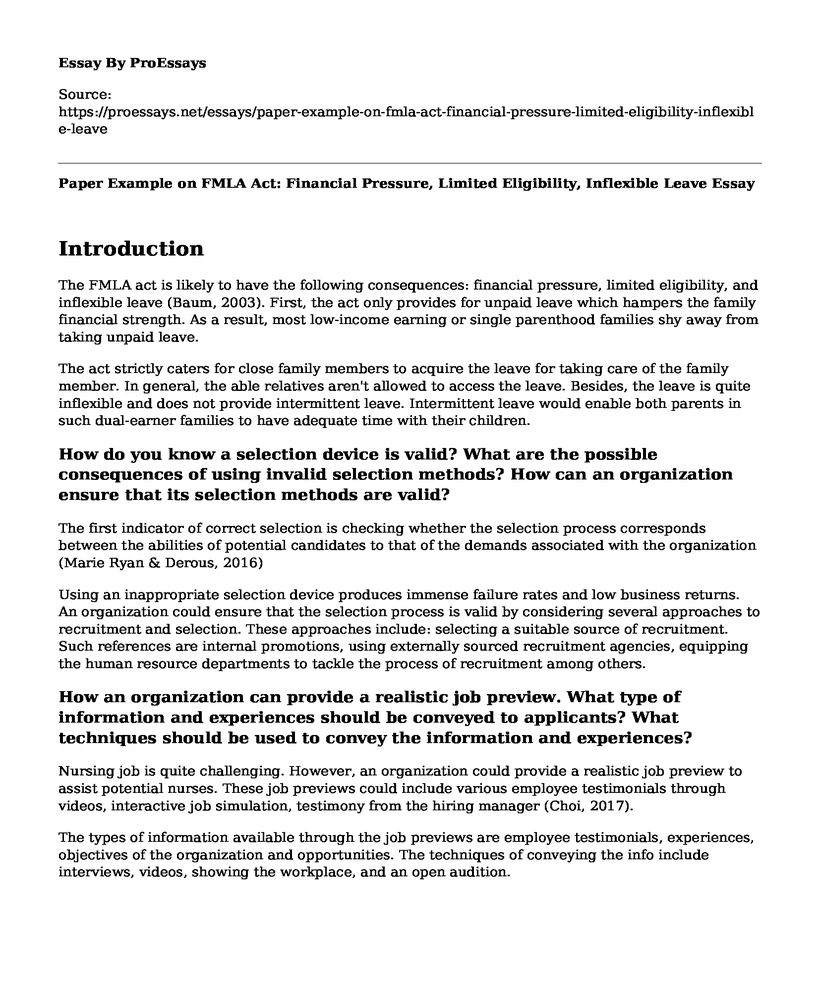Introduction
The FMLA act is likely to have the following consequences: financial pressure, limited eligibility, and inflexible leave (Baum, 2003). First, the act only provides for unpaid leave which hampers the family financial strength. As a result, most low-income earning or single parenthood families shy away from taking unpaid leave.
The act strictly caters for close family members to acquire the leave for taking care of the family member. In general, the able relatives aren't allowed to access the leave. Besides, the leave is quite inflexible and does not provide intermittent leave. Intermittent leave would enable both parents in such dual-earner families to have adequate time with their children.
How do you know a selection device is valid? What are the possible consequences of using invalid selection methods? How can an organization ensure that its selection methods are valid?
The first indicator of correct selection is checking whether the selection process corresponds between the abilities of potential candidates to that of the demands associated with the organization (Marie Ryan & Derous, 2016)
Using an inappropriate selection device produces immense failure rates and low business returns. An organization could ensure that the selection process is valid by considering several approaches to recruitment and selection. These approaches include: selecting a suitable source of recruitment. Such references are internal promotions, using externally sourced recruitment agencies, equipping the human resource departments to tackle the process of recruitment among others.
How an organization can provide a realistic job preview. What type of information and experiences should be conveyed to applicants? What techniques should be used to convey the information and experiences?
Nursing job is quite challenging. However, an organization could provide a realistic job preview to assist potential nurses. These job previews could include various employee testimonials through videos, interactive job simulation, testimony from the hiring manager (Choi, 2017).
The types of information available through the job previews are employee testimonials, experiences, objectives of the organization and opportunities. The techniques of conveying the info include interviews, videos, showing the workplace, and an open audition.
How would managing non-unionized workers differ from managing workers who have elected to be in a union? Which would be easier? Why?
Managing non-unionized workers is very different from non-unionized ones; these differences lie in the wages and salaries, job benefits and work environment, complaints and grievances (cam, 2013). The unionized workers have all their issues done by their respective unions while non-unionized employees confront their employers personally.
Managing unionized employees is far much easier compared to the non-unionized ones. Unionized workers have got a unified voice through a single strong union that bargains on their behalf.
In what ways would managing temporary employees be both easier and more difficult than managing traditional permanent employees? How might you personally choose to behave if you were in a contingent of temporary job versus a traditional permanent job?
Managing temporary employee gives an employer freedom of handling specific tasks at specified intervals flexibly such that the employer can hire and lay off employee whenever the task ends (Kawada, 2016). However, permanent employees are not easily laid off. Meanwhile, an organization that hires permanent employees spend a lot of resources in continually training new workers to tackle such projects.
I would prefer being in a traditional permanent job. This because one gains adequate experiences and stability of the course of work. Moreover, the employer cannot easily lay off a stable employer unless on specified grounds laid out in the code of conduct.
References
Baum, C. (2003). The effect of state maternity leave legislation and the 1993 Family and Medical Leave Act on employment and wages. Labour Economics, 10(5), 573-596. doi: 10.1016/s0927-5371(03)00037-x
Marie Ryan, A., & Derous, E. (2016). Highlighting Tensions in Recruitment and Selection Research and Practice. International Journal Of Selection And Assessment, 24(1), 54-62. doi: 10.1111/ijsa.12129
Choi, S. (2017). Realistic job preview for social enterprise: conceptual and practical propositions on applicant job attraction. International Journal Of Social Entrepreneurship And Innovation, 1(1), 1. doi: 10.1504/ijsei.2017.10000586
Cam, S. (2013). Non-unionised migrant workers in Britain: Evidence from the Labour Force Survey for a triple-challenge model. Economic And Industrial Democracy, 35(3), 531-556. doi: 10.1177/0143831x13489357
Kawada, T. (2016). Do temporary workers have a higher risk of occupational injury than permanent employees?. Public Health, 137, 204-205. doi: 10.1016/j.puhe.2015.11.011
Cite this page
Paper Example on FMLA Act: Financial Pressure, Limited Eligibility, Inflexible Leave. (2022, Dec 29). Retrieved from https://proessays.net/essays/paper-example-on-fmla-act-financial-pressure-limited-eligibility-inflexible-leave
If you are the original author of this essay and no longer wish to have it published on the ProEssays website, please click below to request its removal:
- Cost-Volume-Profit (CVP) Questions and Answers
- Partnership Grand Proposal Paper Example
- President Franklin Roosevelt's 100% Tax Plan Essay Example
- Paper Example on GM Strike: UAW Seeks Better Pay, Improved Working Conditions
- Office Environment: Key to Employee Happiness and Productivity - Report Example
- Essay Example on Cultural Impact on Financial Education at Chase Bank
- NIH Employees Need a Union: Reasons Why - Essay Sample







